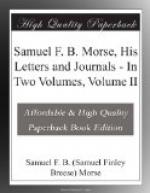“We arrived in the afternoon at Copenhagen. Mrs. F. called in her carriage. We drove to the Thorwaldsen Museum or Depository where are all the works of this great man. This collection of the greatest sculptor since the best period of Greek art is attractive enough in itself to call travellers of taste to Copenhagen. After spending some hours in Thorwaldsen’s Museum I went to see the study of Oersted, where his most important discovery of the deflection of the needle by a galvanic current was made, which laid the foundation of the science of electro-magnetism, and without which my invention could not have been made. It is now a drawing school. I sat at the table where he made his discovery.
“We went to the Porcelain Manufactory, and, singularly enough, met there the daughter of Oersted, to whom I had the pleasure of an introduction. Oersted was a most amiable man and universally beloved. The daughter is said to resemble her father in her features, and I traced a resemblance to him in the small porcelain bust which I came to the manufactory to purchase.”
“St. Petersburg, August 8, 1856. Up to this date we have been in one constant round of visits to the truly wonderful objects of curiosity in this magnificent city. I have seen, as you know, most of the great and marvellous cities of Europe, but I can truly say none of them can at all compare in splendor and beauty to St. Petersburg. It is a city of palaces, and palaces of the most gorgeous character. The display of wealth in the palaces and churches is so great that the simple truth told about them would incur to the narrator the suspicion of romancing. England boasts of her regalia in the Tower, her crown jewels, her Kohinoor diamond, etc. I can assure you that they fade into insignificance, as a rush-light before the sun, when brought before the wealth in jewels and gold seen here in such profusion. What think you of nosegays, as large as those our young ladies take to parties, composed entirely of diamonds, rubies, emeralds, sapphires and other precious stones, chosen to represent accurately the colors of various flowers?— The imperial crown, globular in shape, composed of diamonds, and containing in the centre of the Greek cross which surmounts it an unwrought ruby at least two inches in diameter? The sceptre has a diamond very nearly as large as the Kohinoor. At the Arsenal at Tsarskoye Selo we saw the trappings of a horse, bridle, saddle and all the harness, with an immense saddle-cloth, set with tens of thousands of diamonds. On those parts of the harness where we have rosettes, or knobs, or buckles, were rosettes of diamonds an inch and a half to two inches in diameter, with a diamond in the centre as large as the first joint of your thumb, or say three quarters of an inch in diameter. Other trappings were as rich. Indeed there seemed to be no end to the diamonds. All the churches are decorated in the most costly manner with diamonds and pearls and precious stones.”




